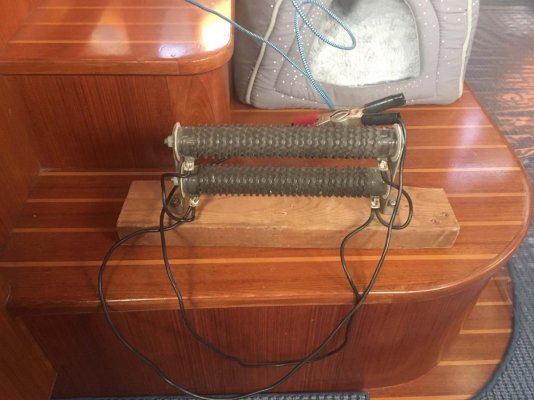ChristineKling
Veteran Member
It turns out it ain't easy!
We made the decision to go with Firefly 4V batteries on our newly constructed boat, Möbius, about two years before the boat launched. In the interim, Firefly has revised their battery manual in the latest May 2021 edition. There is now this section on how to perform a "Restoration Charge."
Restoration Charge
As stated, Firefly Batteries can operate in a partial state of charge for long periods of time without sustaining any permanent damage. The usable capacity will decrease, however, with each cycle within a partial state of charge, up to a point. In order to regain the full original capacity and in some cases more, it is necessary to perform a restoration charge. To perform the restoration charge: charge the G31 to 14.4V or the 4V/450AH to 4.8V and continue to charge until the current drops to 0.5 A on the G31 or 3A on a 4V/450AH and apply a float charge of 13.5V(4.5V for 4V model) for 24 hours. Fully discharge the battery to 10.5V (G31) or 3.5V (4V/450AH), and then repeat the same charge cycle.
Turns out it is actually difficult to drain a huge battery bank that low (we have 24 of these batteries) on a complex boat, especially when living aboard. We are able to break our large 24V bank into two separate 24V banks and work at discharging one bank while living off the other, which might sound strange, but there is very little aboard that will continue to run at a low voltage. Wayne has been able to tweak the settings on the Victron inverters so they don't shut down quite so soon, but we need to get our 24V bank down to 21V! All the LED lights just aren't going to do it.
A few days ago I came back to the boat and Wayne was running the DC bow thruster back and forth. It didn't put a dent in the amps we need to dump. Now he's looking into putting an additional DC water heater element in our AC water heater.
Anyone have any thoughts about how to drain these batteries without damaging the equipment?
By the way, if you have Firefly Batteries on your boat, I've started a Facebook Group where we can share information about this and other Firefly issues. Please join. https://www.facebook.com/groups/899302057442444/
We made the decision to go with Firefly 4V batteries on our newly constructed boat, Möbius, about two years before the boat launched. In the interim, Firefly has revised their battery manual in the latest May 2021 edition. There is now this section on how to perform a "Restoration Charge."
Restoration Charge
As stated, Firefly Batteries can operate in a partial state of charge for long periods of time without sustaining any permanent damage. The usable capacity will decrease, however, with each cycle within a partial state of charge, up to a point. In order to regain the full original capacity and in some cases more, it is necessary to perform a restoration charge. To perform the restoration charge: charge the G31 to 14.4V or the 4V/450AH to 4.8V and continue to charge until the current drops to 0.5 A on the G31 or 3A on a 4V/450AH and apply a float charge of 13.5V(4.5V for 4V model) for 24 hours. Fully discharge the battery to 10.5V (G31) or 3.5V (4V/450AH), and then repeat the same charge cycle.
Turns out it is actually difficult to drain a huge battery bank that low (we have 24 of these batteries) on a complex boat, especially when living aboard. We are able to break our large 24V bank into two separate 24V banks and work at discharging one bank while living off the other, which might sound strange, but there is very little aboard that will continue to run at a low voltage. Wayne has been able to tweak the settings on the Victron inverters so they don't shut down quite so soon, but we need to get our 24V bank down to 21V! All the LED lights just aren't going to do it.
A few days ago I came back to the boat and Wayne was running the DC bow thruster back and forth. It didn't put a dent in the amps we need to dump. Now he's looking into putting an additional DC water heater element in our AC water heater.
Anyone have any thoughts about how to drain these batteries without damaging the equipment?
By the way, if you have Firefly Batteries on your boat, I've started a Facebook Group where we can share information about this and other Firefly issues. Please join. https://www.facebook.com/groups/899302057442444/


